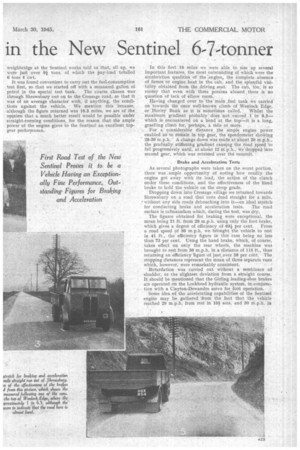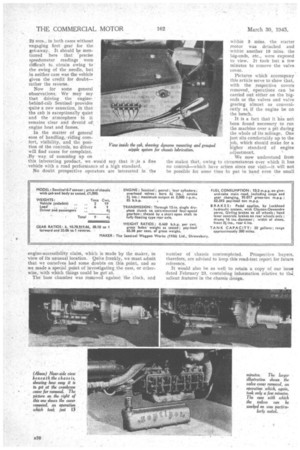Power to in the New Sentinel 7-tonner
Page 26

Page 27

Page 28

If you've noticed an error in this article please click here to report it so we can fix it.
IN our issue dated February 23, we -gave the first technical particulars of the new Sentinel 6-7-tonner, and before this description had actually appeared we visited the works at Shrewsbury for the purpose of subjecting the machine to our usual road test. Before dealing with its perform' ance, however, it would be as well to touch on certain' features in the design wlAch a close inspection of the vehicle revealed.
The fact that the engine is mounted on its side beneath the chassis behind the cab means that provision has to be made for hand cranking from the front, as with aunit mounted in the orthodox way. This is provided for by running a universally jointed shaft forward to another shaft carried in the base of a casting, on the upper end of which the dynamo is mounted in tandem with the four-bladed fan.
These two components are driven by a duplex chain running in an oil-tight casing. The height of the dynamcs. is such that it obtrudes into the cab, where it is at once accessible merely by removing its co*ling. Anoth.er short shaft is taken forward from the, dynamo-cum-fan drive-shaft to provide means for hand cranking.
Incidentally:, the rear end of the dynamo cowling-is. made in the, form of a shutter, which can be revolved so as to regulate the supply of warm air from the radiator into the cab. .
Under the driver's seat comes the 12-volt battery, in which position it is well protected, and on the mate's side of the cab there is a toolbox in the floor, the sloping lid of which forms a convenient foot-rest.
, Generous Bearing Areas . . .
By way of supplementing our description of the engine, it
may be mentioned that the crankshaft is Mounted on five bearings, the front main bearing being 3 ins. dia.; by 2i• ins. long, • and the rear main :hearing 3 :ins. dia. by 3i ins. long. The centre bearing is 3 ins, dia.' by 2i ins, and' the two inner bearings 3 ins. die. by It ins... The crankpins, .too, arc robust, being -21 ins. dia. and ,.2 ins. long.
Piston rock is reduced to a minimum by the use of long skirted pistons, and as the load is taken on the lower side, where there is a tendency for lubrication, to • be most generous, it ,has been found that cylinder-bore wear is unusually low. . It should be remarked here that the prototype vehicle has covered over 200,000 miles, so that ample opportunity has :beeu found for checking up on this feature. There are three compression rings and a scraper to each
piston, all being above the gudgeon-pin. • Driven from the front end of the camshaft is the water pump, which is provided with a. carbon gland; this, has been found to give excellent results, having removed troubles so often associated with water-purnp glands. • The distributor takes its drive from 'therear end of the camshaft, which receives its own.drive from the crankshaft by duplex chain providedwith a suitable tensioning device. A gear-type oil pump; 'also driven from the ,camshaft, is • 24
responsible for maintaining the.:oil pressure. Three gallons of oil are carried in the sump; we understand that in. the matter of oil consumption the 'engine' shows a remarkably
economical figure.• . • One of the accompanying pictures shows, amongst other features, a 'group of nipples mounted alongside the driving
seat. These are piped 4to the various points needing lubrication on the chassis, so that there is no excuse for not giving periodical attention in this direction.
So much then for the descriptive side. Regarding the performance of the Sentinel' on the road, we can say at thp outset that this was of a particularly high order. The weighbridge at the Sentinel works told us that, all up, we were just over 91 tons, of which the pay-load totalled 6 tons 4 'cwt.
It was found convenient to carry out the fuel-consumption .test first, so that we started off with a measured gallon of
petrol in the special test tank. The course chosen was through Shrewsbury out on to the Cressage road, so that it was of an average character with, if anything, the conditions against the vehicle. We mention this because, although the figure returned was 10.3 miles, we are of the opinion that a much better result would be possible under straight-running conditions, for the reason that the ample power of the engine gives to the Sentinel an excellent topgear performance. In this first 10 miles we were able to size up several important features, the most outstanding of which were the acceleration qualities of the :engine,, the complete absence of fumes or engine heat in the cab: and the splendid visibility obtained from the driving .seat. The Cab, too, is so roomy that even with three persons aboard there is no question of lack of elbow room.• Having changed over to the main .fuel tank .1:ye carried on towards the once well-known climb of Wenlock Edge,
or Hartek 13ank aS it is sometimes called. Whilst the maximum gradient probably:: does :not exceed. 1" in 6.5— which is .encounWed on a bend at the top—it is a long,
gruelling climb for, perhaps, a Mile" or more. ,.
For a considerable distance,. the ampleengine power enabled us to remain in top gear, the speedometer showing 28-30 m.p.h.A change down Was made at about 20 m.p.h., the gradually stiffening 'gradient causing the road speed to fall progressively until, at aboht 12" m.P.h., we dropped into -second gear, which was retained over the summit.
, Brake and Acceleration Tests As several photographs were taken on the worst portion, there was ample opportunity of noting how readily the enghie got away with its load, the action of the clutch under these conditions, and the effectiveness of the hand brake to hold the vehicle on the steep grade.
Dropping down into Cressage.village we returned towards Shrewsbury on a road that runs dead straight for a mile, without any side roads debauching into it—an idea/ stretcl.
for conducting brake and acceleration tests. The road surface is tahnacadarn which, during the test, was dry. The figures obtained for braking were exceptional, the mean being 21 ft. from 20 m.p.h. using only the foot brake, which gives a. degree of efficiency of 63i per cent. From a road speed of 30 m.p.h. we brought the vehicle to rest in 41 ft„ the efficiency figure in this case being no less than 73 per cent. Using the hand brake, which, of course, takes effect on only the rear wheels, the machine was brought to rest from 30 m.p.h. in a .distance of 115 ft., thus
returning an efficiency 'figure of just...over 26 per cent, The stopping distances represent the mean of three separate runs which, however, were remarkably consistent.
Retardation was carried out without a semblance of shudder, or the slightest deviation from a straight course, It should be mentioned that the Girling leading-shoe brakes are operated on the Lockheed hydraulic system, in.conjunction with a Clayton-Dewandre servo for foot operation.
Some idea of the accelerating capabilities of the Sentinel engine may be gathered from the fact that the vehicle reached 20 m.p.h. from rest in I0tsecs, and 30 m.p.h. in 23 secs, in both cases without engaging first gear for the get-away. It should be mentioned here that 'precise speedometer readings were difficult tc obtain owing to • the swing of the needle, but in neither case was the vehicle given the credit for doubt— rather the reverse.
Now for some general observations; We may say that driving the enginebehind-cab Sentinelprovides quite a new sensation, in that the cab is exceptionally quiet and the atmosphere in it remains clear and devoid of. engine heat. and fumes.
In the matter of general ease of handling, riding comfort, visibility, and the, position of the controls, no driver will find cause for complaint. By way of summing up on this interesting product, we would say that it-..is a vehicle with a road performance of a high standard.
No doubt prospective operators are interested in
engine-accessibility, claim, which is made by the maker, in view of its unusual location. Quite frankly, we must admit that we ourselves had some doubts on: this.point, and so we made a special point of investigating .the ease, or other
wise, with which things could be gotat.
The base chamber was removed against the Clock, and
within 3. mins, the starter motor was detached and within another 10 mins, the big-ends, etc., were exposed to view. It took but a few cmoivneurt.es to remove the valve
Pictures which accompany this article serve to show that, with the respective covers removed, operations can he carried out either on the big. ends or the valves and valve gearing almost as conveniently as,, if the engine be on the bench, It is a fact that it has not been found necessary to run the machine over a pit during the whole of its mileage. One just sits comfortably up to the job, which should make for a higher standard of engine adjustment.
We now understand from the maker that, owing to circumstances over which it has no control—which have arisen since our visit—it will not be possible for sal-0e Lime to put in hand even the small
number of chassis contemplated. Prospective buyers, therefore, are advised to keep this road-test report for future reference.
It would also he as well to retain a copy of our issue dated February 23, containing information relative to ttai, salient features in the chassis design.




















































